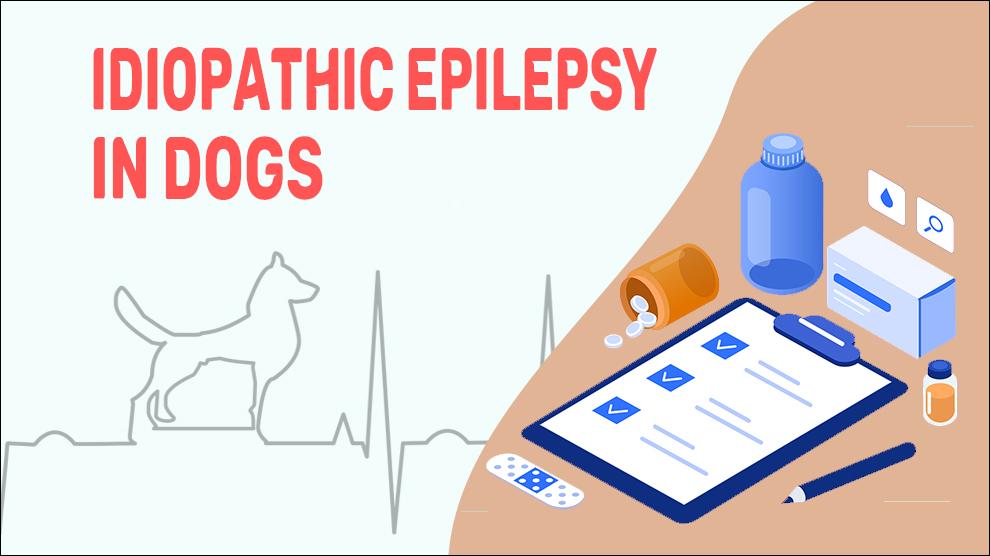What Is Idiopathic Epilepsy In Dogs?
The term ‘epilepsy’ is defined not as one disorder but as disorders of various etiologies with a common element - ‘seizures’ due to intermittent, spontaneous, and/or brain’s abnormal neuronal activity.
Epileptic means the dog suffers from more than 2 seizures resulting from a non-toxic, non-metabolic, unprovoked cause that has a time difference of no less than 24 hours apart. There is no particular time for the occurrence of an Epileptic seizure and it can happen at any time of day while the pet is sleeping, awake, or playing. Typically, most seizures last for 30-120 seconds.
Epileptic seizures can result from:
- Symptomatic/structural – This happens to damage in the brain (tumors, injury, infection, etc)
- Reactive - A response of the healthy brain to a transient disturbance (toxic/ metabolic insult)
- Idiopathic – An unidentified or genetic cause
Idiopathic generalized epilepsy ((IGEs) is a subtype of generalized epilepsy and consists of juvenile absence epilepsy, generalized tonic-clonic seizures, and juvenile myoclonic epilepsy alone. They account for 20% of all epileptic seizures.
Idiopathic epileptic seizures have three different segments.
The pre-ictal phase (aura): The period before the actual seizure and changes in the dog's behavior.
Ictal phase: “ictus” is the actual medical term for seizure. This is a transient, unprovoked electrical activity in the brain.
The post-ictal phase: After the end of the seizure episode, the dog would be in an unsettled, disoriented state. The seizures can be a scary time for the dogs and the post-ictal phase can last up to an hour.
Symptoms Of Idiopathic Epilepsy In Dogs
The pre-ictal phase stage:
- Startled or panic behavior
- Nausea or visual changes
- Confusion. Hiding
- Shake or whine
- Clinging to owner
The “ictal” stage:
- Shivering/jerking movements
- Paddling/ Kicking limbs
- Teeth grinding
- Dazed and disoriented
- Salivation or excessive drooling
- Stiffness
- Urination/ Defecation
- Vocalization
Treatment Options For Idiopathic Epilepsy In Dogs
There is no specific cure for Idiopathic Epilepsy but it can be treated to relieve symptoms.
- Anxiety medications such as buspirone(BuSpar), Alprazolam (Xanax), and Clomipramine (Anafranil).
- Pain medications such as firocoxib (Equioxx), carprofen (Zinecarp or Canidryl), grapipant (Galliprant), meloxicam (Loxicom), deracoxib (Deramaxx), etc.
- Antiepileptic drugs (AED): Potassium bromide (K-BroVet, Libromide), Phenobarbital(Luminal), diazepam(Valium).
- Second generation AEDs: Levetiracetam (Keppra), felbamate(Felbatol), zonisamide (Zonegran), gabapentin (Neurontin) and topiramate (Topamax).
- Third generation AED: Rufinamide (Banzel), Lacosamide (Vimpat).
Home Remedies For Idiopathic Epilepsy In Dogs
- The home remedies should focus on reducing the occurrence and severity of the seizures.
- Epileptic medications may have a lot of side effects; however, the benefits often really outweigh the risk.
- Regular follow-up with your vet can make the life of the dog comfortable.
- It is good to keep a seizure diary to note the significant happenings.
Prevention Of Idiopathic Epilepsy In Dogs
- Sit near the dog and pacify them
- Rest your dog on his side, on the floor, cushion the pet’s head
- Note the duration of the seizure
- Clear out the surroundings. Remove any hard and sharp objects nearby
- Never keep your hands near the dog’s mouth
- Gently and soothingly stroke your pet
- Record the time of revival
- Preferably, record or take a video of any observed specific seizure behaviors
This will be helpful to report to the veterinarian about starting time, overall duration, and any other detailed descriptions of the seizure.
Affected Dog Breeds Of Idiopathic Epilepsy
Australian Shepherd, Belgian Tervuren, German Shepherd, Beagle, Bernese Mountain Dog, Border Collie, Border Terrier, Cavalier King Charles Spaniel, Dachshund, English Springer Spaniel, Finnish Spitz, Golden Retriever, Labrador Retriever, Wolfhound, Lagotto Romagnolo, Petit Basset Griffon Vendeen, Shetland Sheepdog, Standard Poodle, Vizsla
Additional Facts For Idiopathic Epilepsy In Dogs
1. Causes:
Idiopathic- underlying genetic cause
2. Types of epileptic seizures:
Generalized seizures: Misfiring neuronal activity affects the cortex of cerebral hemispheres. Generalized seizures will result in convulsions and loss of consciousness.
Partial (focal) seizure: Initially, one particular region of the cortex is activated. They may show simple symptoms such as muscle contractions, and sensory or motor phenomena. This can anytime convert into generalized seizures.
3. Mortality:
Recent studies demonstrate that Epileptic dogs’ lifetime is shorter when compared to non-epileptic dogs.
4. Diagnosis:
- Complete physical exam
- Biochemical analysis, complete blood count, urine test
- Dog’s reflexes
- Cerebral spinal fluid analysis
- Electrocardiogram
- MRI or CT scan.
5. Prognosis:
Epileptic seizures don’t have a proper treatment modality. This is an idiopathic, non-progressive (occasionally progressive) neurological disorder. Treatment is usually supportive and depends on the dog's symptoms.
When To See A Vet For Idiopathic Epilepsy In Dogs?
Contact your vet right away,
- If the seizure episode doesn’t stop within a few minutes.
- If you have any other concerns for the safety of your pet.
Food Suggestions For Idiopathic Epilepsy In Dogs
- Remove foods with additives, refined and processed sugars, Trans fats, emulsifiers, thickeners, and food colorings.
- Minimally processed meat: Seafood, organ meat, and poultry; meats should be pasture-raised or grass-fed, whenever possible.
- Choose softer foods such as mashed, soft, or pureed foods.
- Smaller, more frequent meals of high-quality, high-calorie food.
- Cut down the salt intake of dogs such as from canned soups or frozen meals.
- Antioxidant-packed fruits: Cherries, Blueberries, peeled apple, cantaloupe.
- Provide the right fats- Omega-3 fats.
Conclusion
Most ‘epileptic’ dogs cannot live normal lives if they are not identified early and properly treated. Epileptic treatment is always expensive and many owners opt to euthanize the dog.
Pets can live a longer, quality life with the right supportive care and medications.

















